Heidegger’s resounding warning concerning the technological regime wherein ‘[a]griculture is now the mechanized food industry … [a]ir is now set upon to yield nitrogen, the earth to yield ore, ore to yield uranium …’ echoes antique maledictions upon mining – perhaps the original model of a ‘challenging-forth’ of resources from the earth. Thus we can find in the words of such authorities such as Pliny and Xenophon an anticipation of contemporary ecology, of which Heidegger’s critique is one of the inspirations. According to these authorities, the depths of the earth are placed outside the compass of divine providence. We have been granted stewardship only over the surface, the locus of a sustainable relation to production. Excavating the hidden bounty of the forbidden depths of the earth brings forth as its fruit only avarice and war.1
The perennial nature of this suspicion – right up to contemporary guilt and anxiety over the explosive growth in human activity made possible by the exploitation of mineral resources – makes it all the more peculiar that the central figure of Heidegger’s text is not a coalmine but a hydroelectric dam.
Of course, the waterpower that draws off potential energy from the hydrocycle is no less a tributary of the sun’s power than are the mineral fuels locked up beneath the surface. One might make the distinction between the product of an ongoing process (the hydrocycle) and the geological product of mineralization: A contemporary rereading of the transgressive nature of mining might be that, with the excavation of fossil fuels, man erupts out of his allotted place in seasonal time, into geological time: ‘by tapping the Carboniferous Formation and spewing it up into the sky, we’ve become a volcano that hasn’t stopped erupting since the 1700s’.2
But this is not central to Heidegger’s account. For him, it is the ‘challenging-forth’ of energy, its ‘unlocking’ and ‘storing’ and ‘transmission’, that constitutes the decisive step toward a new economy. And this shift we find at work in the modern history of waterpower as much as in the mineral-fuelled machine economy.
The symbol of the hydroelectric dam, for Heidegger, signifies that even those features of the world with which we originally dwell in a state of mutual belonging are turned, on the model of mining, into mere physical resources. With the hydroelectric dam, the river is alienated from that constellation of man and his work in which man might properly dwell with technology in its ‘poetical’ essence (notably treated in Knut Hamsun’s [1917] Markens Grøde [Growth of the Soil]). The river ceases to poetically ‘reveal’ the world with man; instead, both become slaves to its ‘standing-reserve’.
The case of waterpower is all the more interesting, therefore, in that it does not easily sit either side of a before-and-after narrative of modern technology. It belongs neither to a primal ‘techné’ nor to the modern regime of machine technology powered by fossil fuels. Waterpower is another path, which spans the abrupt change from ‘biological economy to machine economy’, and sometimes intersects with it, but without being a part of its material definition:3
The historical journey of Norway from underdevelopment to industrial modernity is quite singular in the way in which these two paths interact. Hydroelectric power was the key to Norway’s growth in the years before the massive potential of fossil fuels was unlocked (and may well be the key to its future growth after the advent of ‘peak oil’). The ‘prism’ through which Norway refracted global economic expansion and growth5 was largely a product of its geography, and the resulting distribution of (what was, until the petrochemical discoveries of the 1960s) its chief natural resource. This geographical factor continued to exert an influence as industrialization got underway:
This determination of human geography by physical geography held from mediaeval times, when small groups of Norwegian farmers would group together to ensure a local energy source for grinding flour, in the shape of a water wheel.8 The relatively few locations where the flow of water between mountainous peaks could be extracted became centres of population. The waterways not only provided power, but served as a means of transport, providing a ready-made distribution network, with logs floated down the waterways, stored in lakes, to be delivered to the mills, processed and shipped abroad.
During the long unbroken tradition of using waterpower the use of water as power-source has invariably fixed man to the sites where ‘nature’ makes this power available. The use of waterpower limits location, and the energy produced must be consumed on the spot. But the very immovability of hydroelectric energy called for innovative thinking, and prompted some important early industrial developments in Norway.
Sam Eyde, founder of Norsk Hydro, would commercialize Birkeland’s discovery of the electric arc method of nitrogen-fixing, as a way to employ in situ the excess energy harnessed by the hydroelectric power station at Rjukan to produce artificial fertilizer. (The later successor to this mechanism, the Haber-Bosch process, would open up a far more intensive route for artificial fertilization, this time with the use of petrochemicals as a power source. Intriguingly, Haber-Bosch was a side-result of the military development of explosives, much as Birkeland’s discovery of the electric arc nitrogen-fixing mechanism had been an accident while engineering an electrical cannon. As a by-product of the Birkeland-Eyde process, the plant produced Deuterium – a Hydrogen isotope later used by the Germans in their nuclear programme, leading to the allies’ famous 1944 sabotage of Vermok).
Early Norwegian pioneers such as Anders Sveeas fully realized the potential of waterpower and adapted the ancient technology of the waterwheel to industrial purposes, firstly under the regime of mechanical power transmission and then indirectly, through the use of turbines to generate electricity. Nevertheless, it is the later shift from the direct to the indirect that is decisive; it introduces a new, deterritorialised regime of storage and transmission of energy. New methods of power extraction, storage and transmission enabled by hydroelectric prompt the discovery of new natural resources; it becomes possible to utilize the most remote, secret reserves of nature. In line with Heidegger’s account, the ‘potential 15 million kilowatts of hydro-electric power’10 harboured by Norway’s inhospitable topography11 is progressively ‘unlocked’, and the waterfall, from being a natural spectacle, is revealed as power source amenable to ‘rational use’:
From the moment that power can be economically conveyed to any place at which it can be advantageously employed, it becomes possible to utilize such large waterfalls.12
This new reserve of power brought about a re-evaluation of the country itself that echoed a more generalised shift in perception of the importance of ‘natural resources’. In 1919 one writer expects Norway to ‘become one of the greatest, if not the greatest, industrial center of Europe.’, declaring: ‘In possibilities it yields only to America’.13 Thus, before the explosion of industrial innovation brought about by the use of mineral fuels dwarfed any possible alternative, the natural resources of Norway were recognized, in precisely the context of a nascent global energy economy, as constituting the country’s primary ‘wealth’: Det hvite kullet:
Hansen, in 1911, records the role of the wood-pulp industry in the transition from the small-scale use of the waterways which (in an echo of Heidegger) lets these sites be, in their ‘purity’, to the modern economical estimation of the forests and waterways in terms of export-value and ‘productive energy’:
But soon the water-power began to be more and more made use of for the Wood-Pulp Industry, which, in the course of a comparatively short time, grew to be of such importance that now, in conjunction with cellulose and paper, exports represent the annual value of 56 million kroner.
Turbines took the place of water-wheels, and gradually the electric dynamo in connection with the turbine commenced an evolution that has brought water-power into the foremost rank as a source of productive energy.15
Now, it is clear that according to Heidegger, this development belongs to the ‘monstrous’ reign of technology which removes technology as ‘standing reserve’ from the work of poiesis which it originally shares with the work of art, and according to which man can ‘dwell’ – as his famous lament concerning the Rhine suggests:
Compare this with an early twentieth-century, rather more celebratory account of the potential of Norway’s white coal:
In order to make use of the water-power, it is therefore of primary importance to be able to store as much as possible of the supplies which, during the melting of the snows, would escape to sea. On looking at the map, it is obvious that the nature of the country is peculiarly adapted for such storage. The entire country is furnished with lakes of various size, which, owing to the depth and narrowness of the valleys, have frequently very contracted outlets. It is, therefore, easy to convert such lakes, and at comparatively little outlay, into most valuable reservoirs, in which to store in summer the water arising from the winter snows, and, by letting out these stored supplies as required to supplement the natural flow, to maintain the regular amount needed for the production of constant power.17
In Norway, as elsewhere in Europe, the nineteenth century saw a new compact between the artistic and the industrial. Industrial exploitation of the powers of nature was echoed by artists’ romantic fascination with them. In the ‘Nordic sublime’ (Norwegians Peder Balke, J.C. Dahl, the Danish painter of Norway Erik Pauelssen), and the related growth of tourism, in which the ‘wildness’ of nature was staged and presented, a new aesthetic appreciation that emerges in parallel with industrial expansion.
The waterfall is now conceived on a terrestrial-geological scale – it is exhibited by the sublime painters alongside the classic symbols of ocean and volcano, reflected upon in light of the deep geological time that threatens to usurp the biblical chronicle of the earth. This is no longer the poeisis of the waterwheel that gently taps into energy on a human scale, and thus can be opposed to the transgressive extraction of petroleum. In line with the increasingly massive-scale exploitation of the power of water, this art now expresses a fascination with nature no longer as beautiful but as forbidding and overwhelming; a pure power to be marveled at, but also to be mastered.
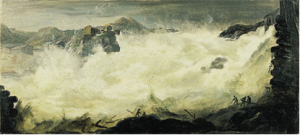
E. Pauelssen, Sarpfossen (1799)
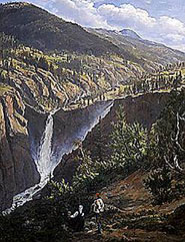
J.C.Dahl, Rjukanfoss (1830)

Theodor Kittelsen, Rjukanfosen (1908)
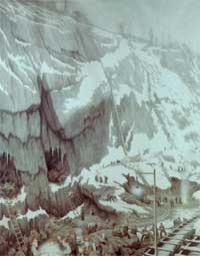
Theodor Kittelsen, Rjukanfosen (1908)
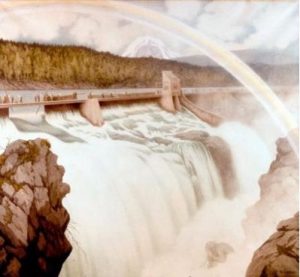
Theodor Kittelsen, Rjukanfosen (1908)
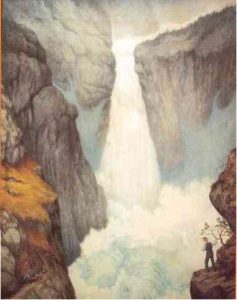
Theodor Kittelsen, Rjukanfosen (1908)
This remarkable series of paintings of the falls at Rjukan, by Theodor Kittelsen (better known as an illustrator of folktales), were commissioned by Sam Eyde as he developed a gigantic power station at Svlegfoss, to be followed by Vermok, where the Rjukanfoss drops one hundred metres at Vermok.18 This latter would become the first hydro-electric plant of its kind, completed in 1934 – at the time a ‘gigantic work … incomparably the largest power station in Europe’.19
In the crucial early decades of the twentieth century, in parallel with such ambitious projects, water had become very self-consciously a symbol of national identity for Norway, and for its increasing anticipation of full modernization, concurrent with the independent ‘rebirth’ of the nation in 1905. In 1906, a law was passed imposing a ban on foreign purchase of waterfalls, bringing them under public control, ensuring through a concession arrangement that these ‘assets’ would eventually revert to the state, and through other measures that the related industries would provide work for Norwegian workers.
This prudent quasi-nationalization of natural resources, fuelling Norwegian economic take-off, was paralleled by an increasing sense of the national ‘aesthetic wealth’ these spectacular resources afford. Scott-Hansen reflects on Norway’s duty to reconcile aesthetic appreciation with industrial exploitation:
Surely there is room for both classes, and surely the land that is in a position amply to satisfy them both, must be considered to be fortunately situated, with wealth and prosperity as well as wealth of scenery.20
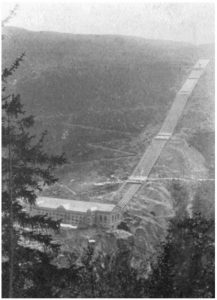
Vermok power station
Contemporary developments suggest that on a rapidly-transforming planet, the age-old path of waterpower, and the highway of modernity – the human project of endless growth and energy consumption – are converging once again.
In China, where the Three Gorges Dam has already been completed after vast expenditure and the displacement of millions of people, controversy now rages over the plans to build a 21.3GW dam in the Nu river, with conservation groups fighting to save the world heritage site’s biodiversity and endangered species. The ambitious Chinese hydroelectric programme addresses not just the growing demands of the new Chinese economy and the potential for cross-border energy sales, but international pressure for reduced fossil fuel emissions.
Meanwhile, ongoing climate change finds energy companies prospecting at the melting ice caps, hoping to find minerals exposed by the retreating ice, and utilize hydroelectric power to process them – a ‘white gold rush’ for new sources to power the global information economy.
REFERENCES
–– H. Dorffman, Labor Relations in Norway (Oslo: Norwegian Joint Committee on International Social Policy, 1966).
–– E. Lo Cascio and P. Malanima, ‘Mechanical Energy and Water Power in Europe: A Long Stability?’ In E. Hermon (ed.), Vers une gestion intégrée de l’eau dans l’Empire Romain (Rome: L’Erma di Bretschneider, 2008). 201-8.
–– Howe, J. L. ‘Notes on Norwegian Industry’, The Popular Science Monthly, Jan. 1912, 36-50.
–– Ljøgodt, K. ‘Sublime Nature’
–– Macalister, T. ‘Melting ice caps open up Arctic for “white gold rush”’
–– Moses, Jonathon W., Norwegian Catch-Up: Development and Globalization before World War II ( Aldershot: Ashgate, 2005).
–– Nynäs, H., ‘Water as a symbol of national identity in Norway’, in The Basis of Civilization – Water Science? (Proceedings of UNHSCO/IAI IS/IW1IA symposium held in Rome. December 2003). IAHS Publ. 286. 2004.
–– Røiri, V., ‘Det hvite kullet’
–– Scott-Hansen A, and Swinburne, J., ‘Hydro-electric plants in Norway and their application to electrochemical industries’, Trans. Faraday Soc., 1911, 7, 78-91.
–– Nina Sørlie (ed.), Johan Christian Dahl (Kistefos-Museet/Labyrinth Press, 2000)
–– Weisman, A., The World Without Us (London: Virgin Books, 2007)
- Agricola, in De Re Metallica (1556), cites the following:
The earth does not conceal and remove from our eyes those things which are useful and necessary to mankind, but on the contrary, like a beneficent and kindly mother she yields in large abundance from her bounty and brings into the light of day the herbs, vegetables, grains, and fruits, and the trees. The minerals on the other hand she buries far beneath in the depth of the ground; therefore, they should not be sought. – Xenophon
And not only was the rich soil required to furnish corn and due sustenance, but men even descended into the entrails of the earth, and they dug up riches, which the earth had removed to the Stygian shades. Then destructive iron came forth, and gold, more destructive than iron; then war came forth – Ovid
To which we might add Pliny’s verdict:
For it is upon her surface, in fact, that she has presented us with these substances, equally with the cereals, bounteous and ever ready, as she is, in supplying us with all things for our benefit! It is what is concealed from our view, what is sunk far beneath her surface, objects, in fact, of no rapid formation, that urge us to our ruin, that send us to the very depths of hell. As the mind ranges in vague speculation, let us only consider, proceeding through all ages, as these operations are, when will be the end of thus exhausting the earth, and to what point will avarice finally penetrate! How innocent, how happy, how truly delightful even would life be, if we were to desire nothing but what is to be found upon the face of the earth; in a word, nothing but what is provided ready to our hands! – Pliny the Elder
In reading Agricola’s counterarguments one can surmise that ultimately this dispute around the nature and distributive mechanism of divine providence in fact already brings into play the modern anthropological question of the proper nature of man, figured through a metaphor of visibility: does the true nature of man (and God’s role for him) consist in a piety and compliance to what is spontaneously given and visible, or in an enterprising extraction of even those plutonic resources that are hidden and which (according to pre-modern thought) ‘grow’ at a rate too slow for their yield to be replaced.
- Weisman 39.
- Lo Cascio and Malanima.
- Ibid.
- In globalization, ‘international influences join with domestic institutions to produce hybrid mixtures … Each nation is a prism through which the global is refracted, at the same time that the global dilutes, homogenises, releases nations from their territorial limitations.’ – Moses 27,43.
- Moses 109.
- Dorfman 10.
- Nynäs 316
- Dorfman 15.
- Ibid. 10.
- ‘The chief physical elements are the mountains and glaciers largely uninhabitable and untillable, covering more than half of Norway. As a matter of fact, more than 70 per cent of the nation’s area is waste land, as far as economic development is concerned’ – Dorfman 7.
- Scott-Hanssen 81
- Howe 41.
- Scott-Hanssen 78.
- Ibid. 79.
- Heidegger, ‘The Question Concerning Technology’.
- Scott-Hanssen 80.
- Nynas 319.
- Scott-Hanssen 88.
- Scott-Hanssen 91. It is unlikely that Heidegger would have been convinced by such a compromise, for he saw how the modern aesthetic of the ‘landscape’ was itself produced contemporaneously with its industrial exploitation: But, it will be replied, the Rhine is still a river in the landscape, is it not? Perhaps. But how? In no other way than as an object on call for inspection by a tour group ordered there by the vacation industry.
